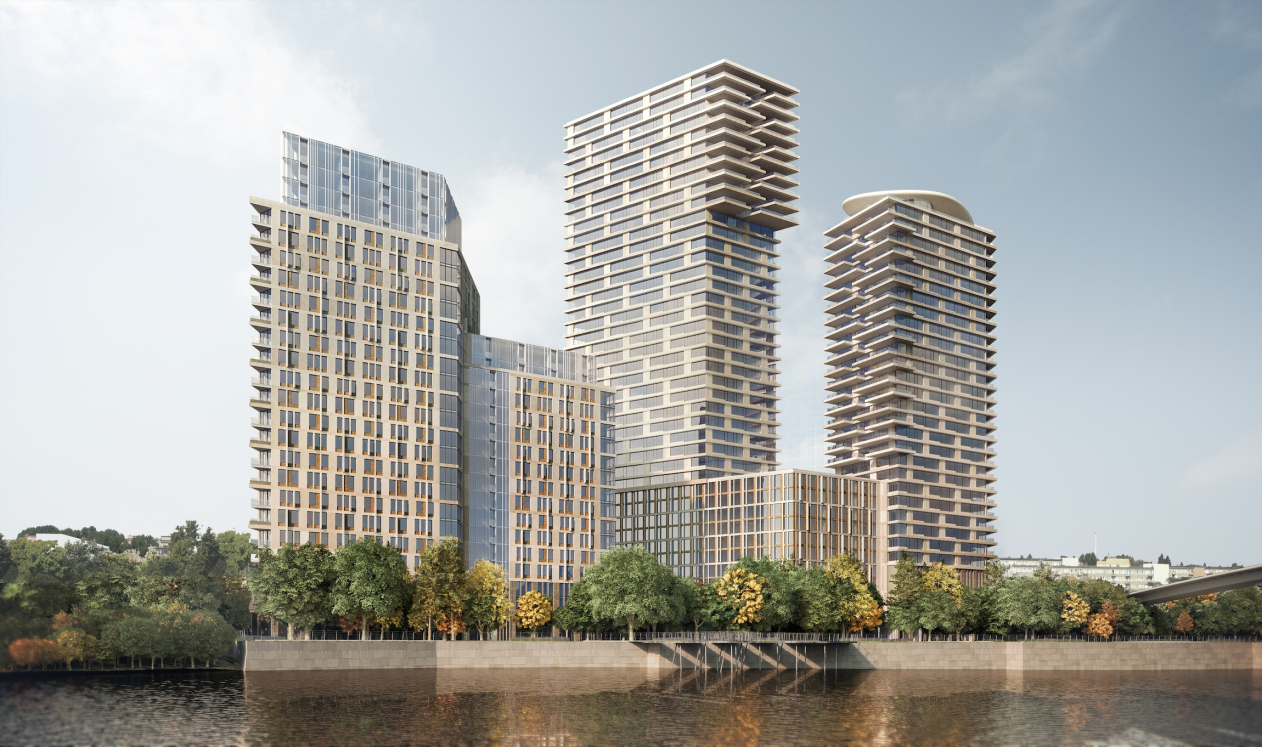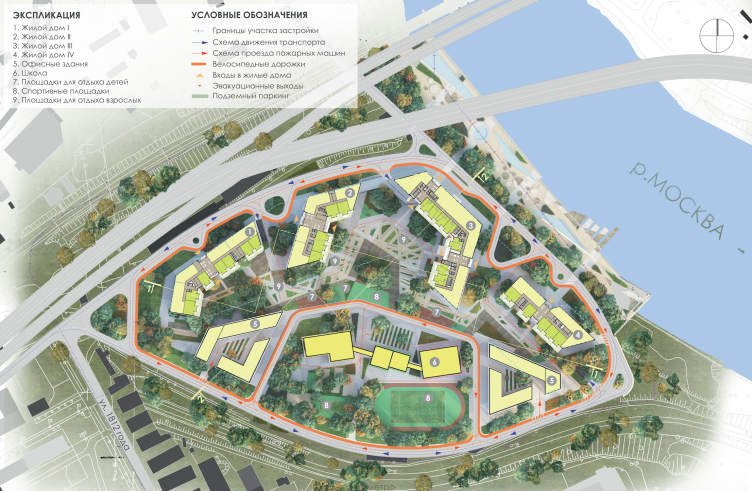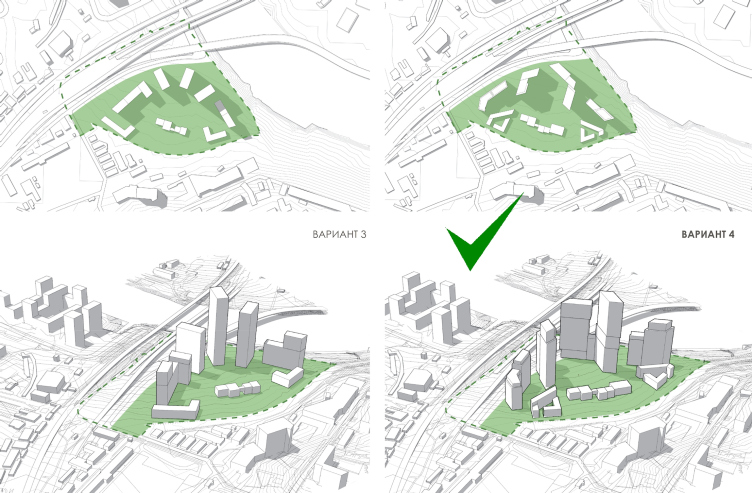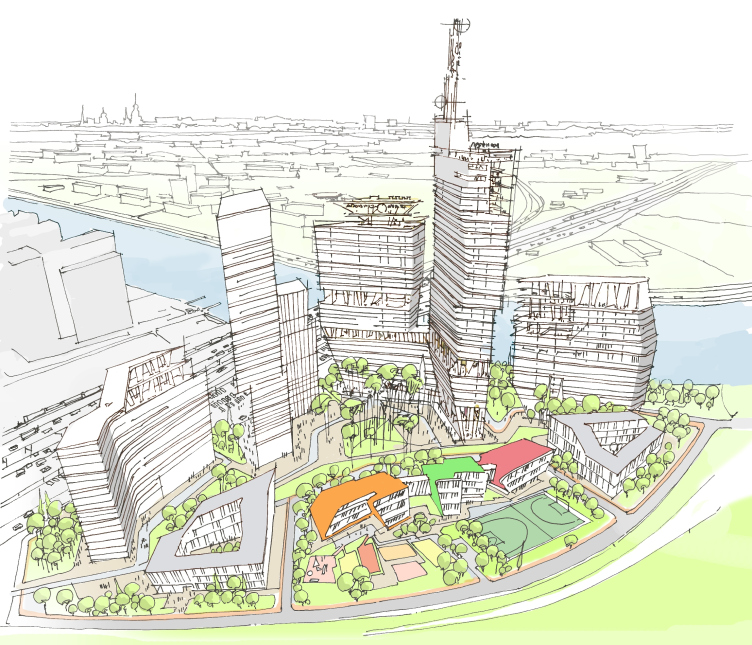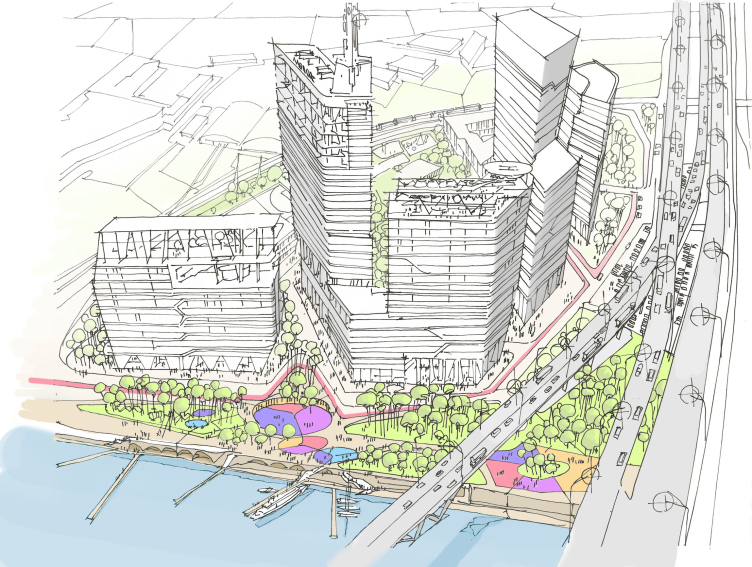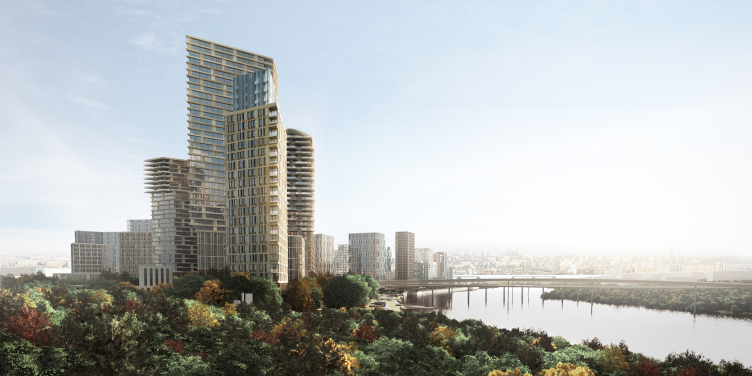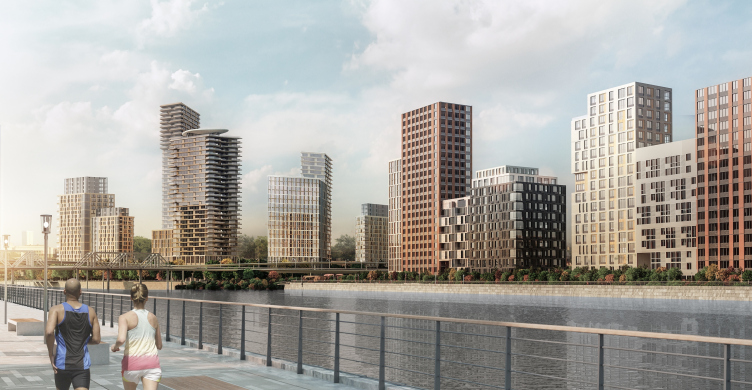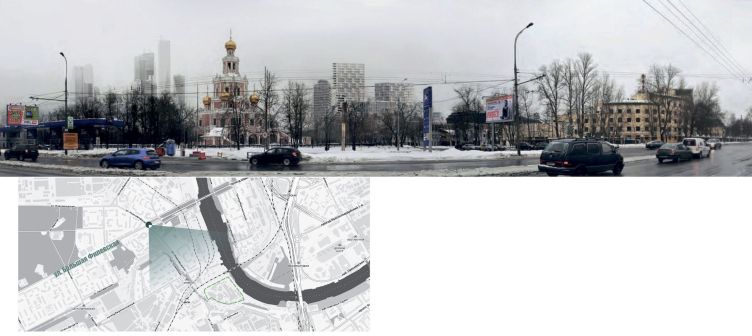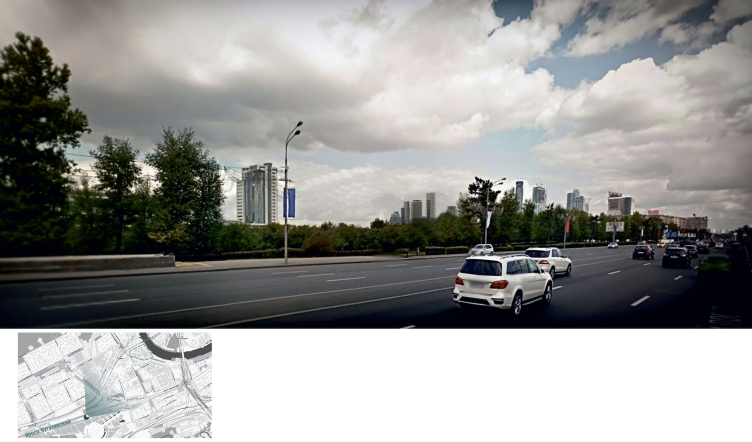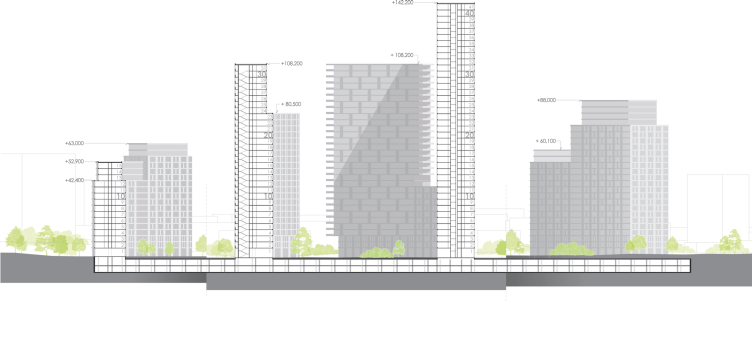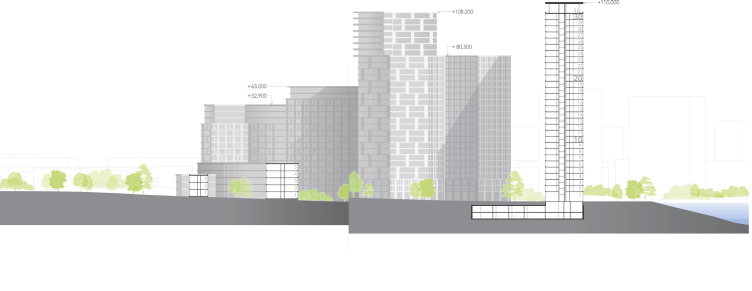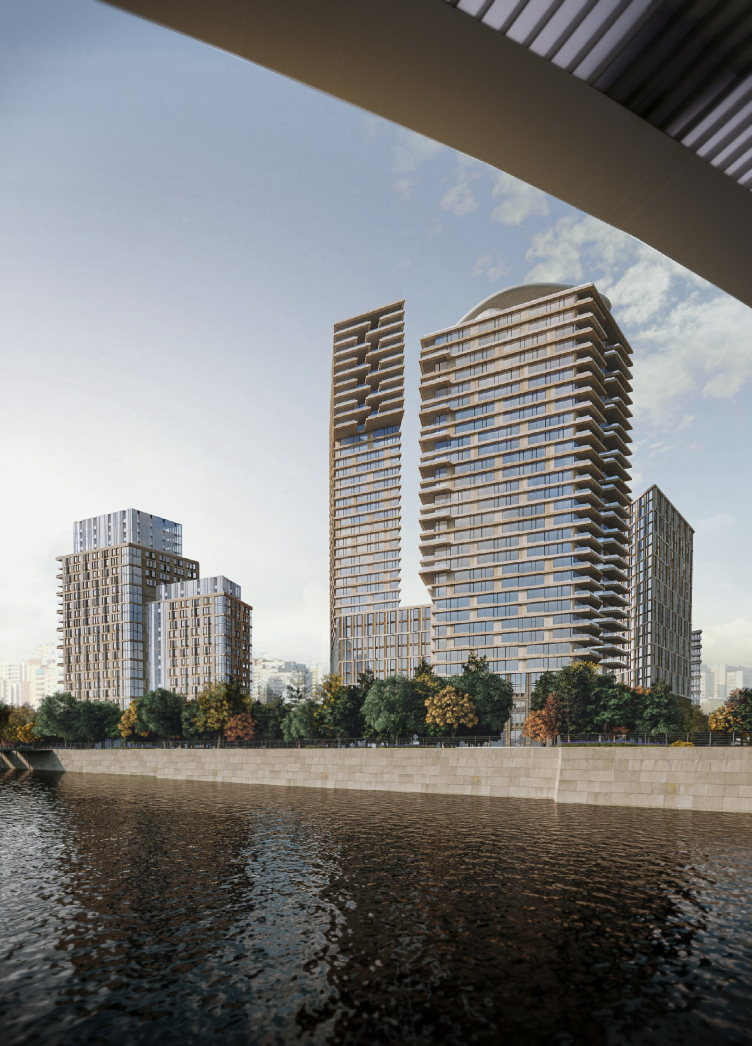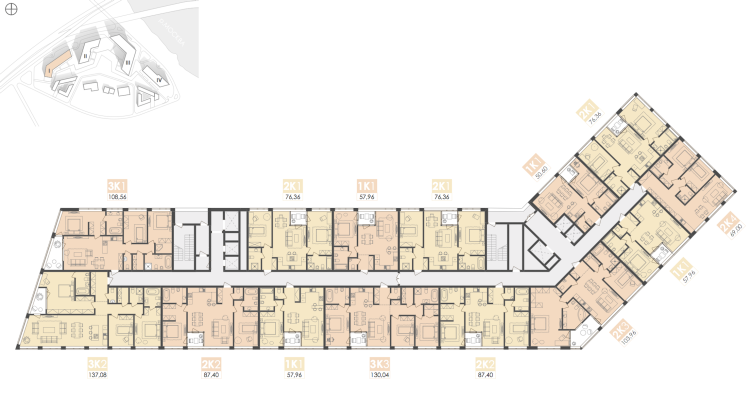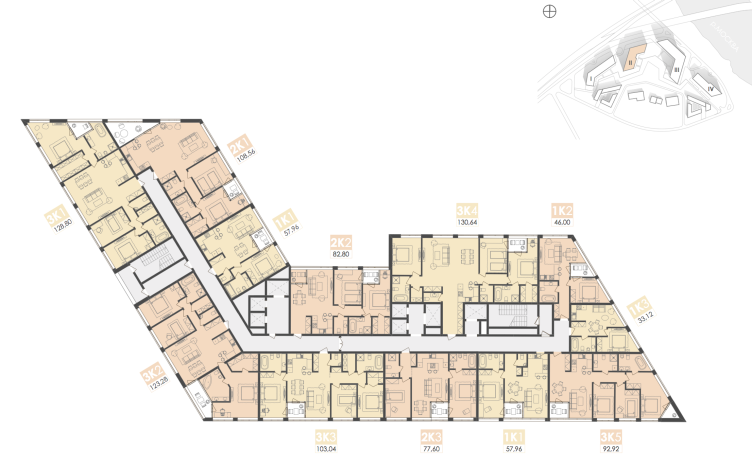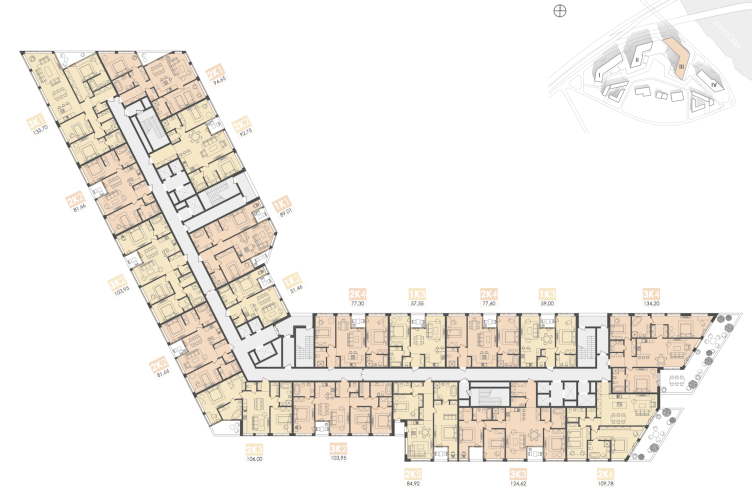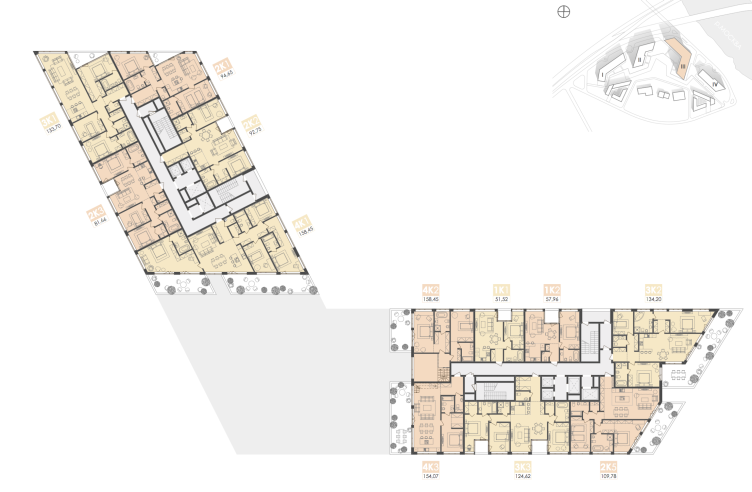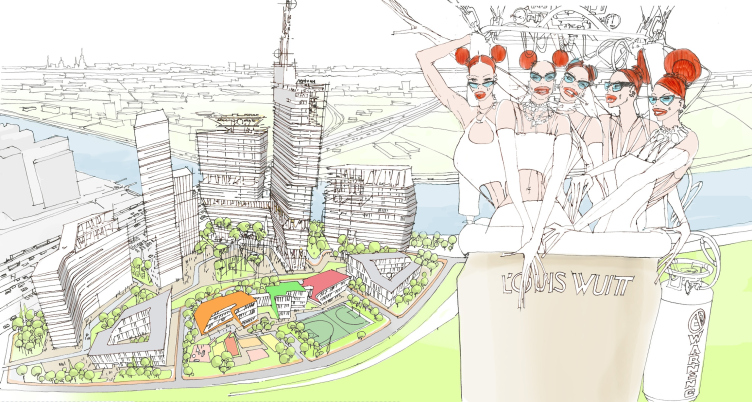Mixed-use complex on the territory of the Milikrovlya factory. Project, 2015 © Archimatika
Mixed-use complex on the territory of the Milikrovlya factory. Limitations. Project, 2015 © Archimatika
“In August of 2015 we were invited to participate in an invitation-only competition for a housing project of great social importance, and we agreed enthusiastically, perceiving this like a certain trust credit, which we did our best to justify” – the architects confess.
The complex form of the land plot made Archimatika refrain from rectangular configuration of the buildings and regular plans of their positioning. The closest of all to the overland metro line are the sports fields, and therefore, the 2-3 stories school building for 500 students, which is situated right behind these sports fields, finds itself the required 50 meters away from the metro line. For other public buildings this figure is slightly lower, and the office buildings 3 to 5 stories high, which flank the academic building, are only 20 meters away from the metro line. And still further away behind them the architects placed four towers of a complex shape, 15 to 41 stories tall. Such a “ledgy” composition made it possible to, first of all, protect the residential buildings from the noise of the metro line, second, set some human-friendly scale of the volumes, and, third, ensure a high degree of insolation for both the inside yard and the residential towers – because this side is the south one.
Mixed-use complex on the territory of the Milikrovlya factory. Master plan. Project, 2015 © Archimatika
Mixed-use complex on the territory of the Milikrovlya factory. Volumetric compositional versions. Project, 2015 © Archimatika
Mixed-use complex on the territory of the Milikrovlya factory. Sketch. Project, 2015 © Archimatika
Mixed-use complex on the territory of the Milikrovlya factory. Sketch. Project, 2015 © Archimatika
The high-rises have a complex shape and form the boundary of the urban block from the side of the traffic junctions – on this side, the architects had to implant the noise protection into the structures of the façades, windows and doors. They are arranged in such a way that virtually all of them catch the sunlight: the substandard insolation time is only found on two small façade fragments, less than 5% of the overall façade surface. At the same time, the towers not only have different shapes with “cavities” and “slits” but are also placed on the north part of the territory in a rather freehand manner. Thanks to this technique, the high-rises signify the conditional boundaries of the urban block, without forming a “fortress wall”, which usually protects the residents not so much from any potential adversaries (of a purely imaginary nature) as from the opportunity to see the sky. At the same time, there appears an interesting nonlinear system of open spaces in between the yards, accessible not only for the residents of the complex and their guests but also for the general public, which is also important for forming a comfortable and human-friendly living environment.
Mixed-use complex on the territory of the Milikrovlya factory. Project, 2015 © Archimatika
Mixed-use complex on the territory of the Milikrovlya factory. Project, 2015 © Archimatika
As a result of the clear-cut planning of the land site and the thought-out traffic pattern (the parking garage is, of course, hidden underground), each of the functional zones, be that the school, the offices or the residential buildings, forms a micro-world of its own, that does not bother all the others. And the landscape, which naturally spills over to the river, becomes the glue that holds them together as a single organism. At the same time, the embankment itself is actively interacting with the city because it becomes a continuation of the neighboring green zone formed within the project of the multifunctional residential complex “Zapadny Port” (“Western Port”) – it is designed by SPEECH, ADM, and TPO “Reserve”.
Mixed-use complex on the territory of the Milikrovlya factory. Photographic montage (crossing of Bolshaya Filevskaya and Novozavodskaya). Project, 2015 © Archimatika
The competition’s brief specified the height restrictions for the new complex – not higher than 110 meters. However, the solution that the architects proposed exceeds this mark by more than 30 meters. “These height restrictions were dictated by the completely understandable desire to keep the panoramas of the city with the Fili Intercession Church – Alexander Popov explains – But studying the situation in detail, we found that the powerful landmark of the Moscow City business center actively influences all of the silhouettes in that area. A paradoxical situation is created: continuing to “haircut” all of the surrounding buildings at a much lower notch, we only highlight the already noticeable and very conspicuous cluster of buildings, thus suppressing – and this is important – the historical buildings, for the sake of which these restrictions were introduced. Of course, we still have to do a thorough analysis of the whole situation from all vantage points but we are positive that creating some landmarks that would set off the pressure of the Moscow City is not only possible but even highly desirable for this city”. As far as the new block itself is concerned, increasing the number of floors turns out to be a very important factor for it because it makes it possible to significantly shrink the construction blueprint, letting in more air and creating a more open “breathing” environment. It was this increase in height that allowed the architects to form the low-rise construction front and set a human-friendly scale supported by the highlights base floors of the towers.
Mixed-use complex on the territory of the Milikrovlya factory. Photographic montage (view from the side of the Kutuzovsky Prospect). Project, 2015 © Archimatika
Mixed-use complex on the territory of the Milikrovlya factory. Section view. Project, 2015 © Archimatika
Mixed-use complex on the territory of the Milikrovlya factory. Section view. Project, 2015 © Archimatika
Mixed-use complex on the territory of the Milikrovlya factory. Layout of the floors in the complex. Project, 2015 © Archimatika
Mixed-use complex on the territory of the Milikrovlya factory. Project, 2015 © Archimatika
Mixed-use complex on the territory of the Milikrovlya factory. Project, 2015 © Archimatika
In order to keep up and enhance this feeling of proportion, the architects tried to visually take some weight off the top part of the building at the expense of the lightened façade design. As a finishing stroke, the architects “landed” on one of the towers a “hovering” snow-white sculptural volume, in which they proposed to organize a unique penthouse or a sightseeing platform with a bar. As far as the main decoration materials are concerned, the architects considered several kinds of stone, and, of course, glass. The large glazed surfaces naturally create a play of highlights and reflections. They also help to increase the quality of the inner space of the apartments at the expense of good insolation and panoramic views.
An important part in forming the fractured pattern of the façade and showing the structure of the buildings is played by the terraces. These are arranged in groups and they are not to be met everywhere. Wherever there are no terraces, the architects designed small glazed recessed balconies of different sizes and different geometric shapes, which essentially become an indispensable part of the inner space of the apartment. By employing this technique, the architects are proposing to solve the problem of outlaw balcony glazing. Yet another typical problem is using the balconies as emergency exits. This solution is both inconvenient (because the extra stairways eat up an extra part of that valuable balcony space and are a nuisance for the residents) and ineffective (because a lot of residents remove their sections of the stairways and stop the openings, in spite of the fact that doing this is illegal). In this specific instance, the architects were able to afford to make two inside emergency staircases, thus freeing all the terraces and balconies from that extra functional load. This made it possible to place the balconies virtually in any conceivable part of the façades. Some of the apartments could get not just one but two such balconies or terraces. Although such planning entails a pretty inconvenient corridor, the architects are promising to make up for this inconvenience by breaking up the longish passage into fragments and decorating it in a nice and interesting way.
Mixed-use complex on the territory of the Milikrovlya factory. Plan of the standard floor (Building 1). Project, 2015 © Archimatika
However, the main result of the freedom of action that the architects got this way was a great number of floor planning options: more than 30 types of apartments, from 35 square meter studios to 160 square meter giants. As we remember, there are no problems with insolation of the façades, and the apartments can be also positioned in different ways. Each of the proposed floor plans has its own strong point: at some places, corner terraces appear, or fragments of living rooms of interesting configuration, at some places a great summer recreation area can be set up, at some places, the bathroom pops up not just next to the bedroom but also next to the terrace (which is extra-convenient), at some places appears a large living room that commands fine city views, at some places – a capacious kitchen or anteroom; some of the apartments can even comfortably house two generations of grownups (two families, in fact), which will not get in each other’s way. And it is this diversity of layouts that fully addresses all of the most diverse behavioral needs that the architects see as the foundation of the future commercial success of their project.
Mixed-use complex on the territory of the Milikrovlya factory. Plan of the standard floor (Building 2). Project, 2015 © Archimatika
Mixed-use complex on the territory of the Milikrovlya factory. Plan of the standard floor (Building 3). Project, 2015 © Archimatika
Mixed-use complex on the territory of the Milikrovlya factory. Plan of the standard floor of the tower (Building 3). Project, 2015 © Archimatika
Mixed-use complex on the territory of the Milikrovlya factory. Plan of the standard floor of the tower (Building 3). Project, 2015 © Archimatika
Mixed-use complex on the territory of the Milikrovlya factory. Plan of the standard floor of the tower (Building 4). Project, 2015 © Archimatika
Mixed-use complex on the territory of the Milikrovlya factory. Sketch. Project, 2015 © Archimatika
In search for new approaches to organizing the life of the families, the architects even came up with a new housing typology – an urban townhouse within a high-rise. From the side of the street, the bottom floors of the towers will be quite habitually occupied by shops, restaurants and other public places, while the inside “transition” yard will be commanded by two-level apartments with an area of about 120 square meters, which will also boast a small terrace with railings. This solution is not exactly a cure-all thing but in many ways it is advantageous because it allows the architects to completely free the residential yard of any public areas, at the same time providing a high level of comfort for the residents of the bottom floors: the bedrooms can be elevated to the second level, while the hedgerow will ensure the necessary level of privacy of the bottom residential floor.
“It stands to reason that because of the fact that we significantly exceeded the height limit our competition proposal is likely to have a lot of opponents – admits Alexander Popov – However, according to our observations, the public opinion on the maximum allowed construction height is not carved in stone: 15 years ago everyone in Moscow tried to build as high as possible; now we are seeing the reverse trend. On the other hand, in London, for example, they are designing and building about 400 high-rise projects, while about a decade ago this figure was two or three times less. The last thing that we want to say is “no, you can’t build them anywhere” or “yes, you can build them everywhere”. What you’ve got to do is think and make out for yourself in which cases the height restrictions do serve to keep up the scale of the environment that surrounds monuments of architecture, and in which cases these restrictions only serve to make architectural monuments out of recently built projects that took into account these restrictions. Because it is thanks to the contrast between the scale of the historical buildings and the new buildings (which are subject to height restrictions) that the recently-built high-rise record breakers involuntarily become architectural centerpieces, the vis-a-vis of the cathedrals and belfries towering above the old town – but here is the question: do they bear the conceptual and esthetic load that stands up to the high status of architectural landmarks?”

